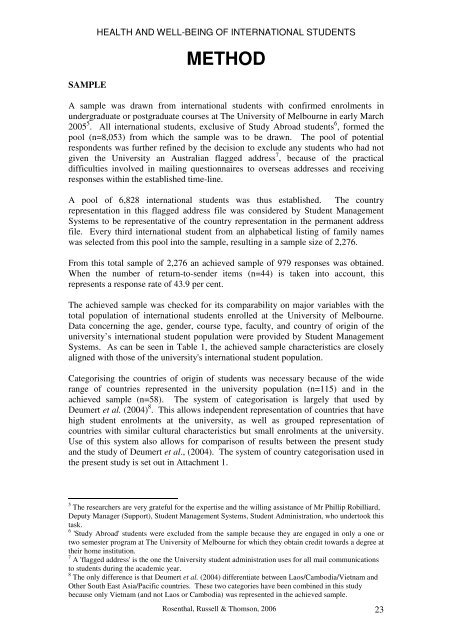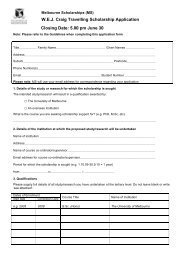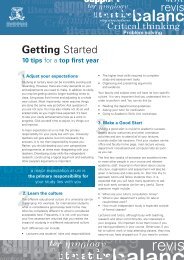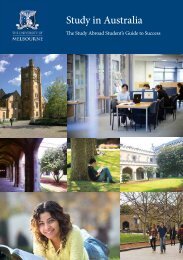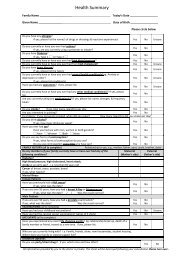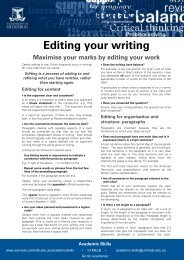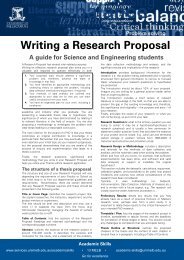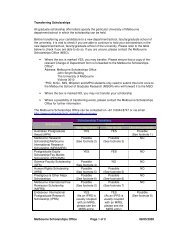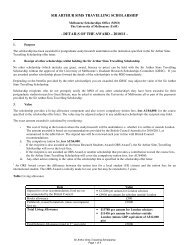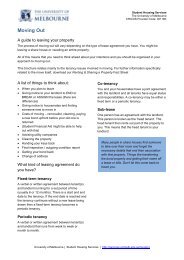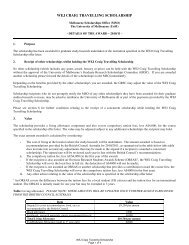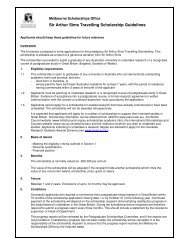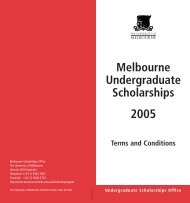a growing experience - Student Services - University of Melbourne
a growing experience - Student Services - University of Melbourne
a growing experience - Student Services - University of Melbourne
Create successful ePaper yourself
Turn your PDF publications into a flip-book with our unique Google optimized e-Paper software.
SAMPLEHEALTH AND WELL-BEING OF INTERNATIONAL STUDENTSMETHODA sample was drawn from international students with confirmed enrolments inundergraduate or postgraduate courses at The <strong>University</strong> <strong>of</strong> <strong>Melbourne</strong> in early March2005 5 . All international students, exclusive <strong>of</strong> Study Abroad students 6 , formed thepool (n=8,053) from which the sample was to be drawn. The pool <strong>of</strong> potentialrespondents was further refined by the decision to exclude any students who had notgiven the <strong>University</strong> an Australian flagged address 7 , because <strong>of</strong> the practicaldifficulties involved in mailing questionnaires to overseas addresses and receivingresponses within the established time-line.A pool <strong>of</strong> 6,828 international students was thus established. The countryrepresentation in this flagged address file was considered by <strong>Student</strong> ManagementSystems to be representative <strong>of</strong> the country representation in the permanent addressfile. Every third international student from an alphabetical listing <strong>of</strong> family nameswas selected from this pool into the sample, resulting in a sample size <strong>of</strong> 2,276.From this total sample <strong>of</strong> 2,276 an achieved sample <strong>of</strong> 979 responses was obtained.When the number <strong>of</strong> return-to-sender items (n=44) is taken into account, thisrepresents a response rate <strong>of</strong> 43.9 per cent.The achieved sample was checked for its comparability on major variables with thetotal population <strong>of</strong> international students enrolled at the <strong>University</strong> <strong>of</strong> <strong>Melbourne</strong>.Data concerning the age, gender, course type, faculty, and country <strong>of</strong> origin <strong>of</strong> theuniversity’s international student population were provided by <strong>Student</strong> ManagementSystems. As can be seen in Table 1, the achieved sample characteristics are closelyaligned with those <strong>of</strong> the university's international student population.Categorising the countries <strong>of</strong> origin <strong>of</strong> students was necessary because <strong>of</strong> the widerange <strong>of</strong> countries represented in the university population (n=115) and in theachieved sample (n=58). The system <strong>of</strong> categorisation is largely that used byDeumert et al. (2004) 8 . This allows independent representation <strong>of</strong> countries that havehigh student enrolments at the university, as well as grouped representation <strong>of</strong>countries with similar cultural characteristics but small enrolments at the university.Use <strong>of</strong> this system also allows for comparison <strong>of</strong> results between the present studyand the study <strong>of</strong> Deumert et al., (2004). The system <strong>of</strong> country categorisation used inthe present study is set out in Attachment 1.5 The researchers are very grateful for the expertise and the willing assistance <strong>of</strong> Mr Phillip Robilliard,Deputy Manager (Support), <strong>Student</strong> Management Systems, <strong>Student</strong> Administration, who undertook thistask.6 'Study Abroad'students were excluded from the sample because they are engaged in only a one ortwo semester program at The <strong>University</strong> <strong>of</strong> <strong>Melbourne</strong> for which they obtain credit towards a degree attheir home institution.7 A 'flagged address'is the one the <strong>University</strong> student administration uses for all mail communicationsto students during the academic year.8 The only difference is that Deumert et al. (2004) differentiate between Laos/Cambodia/Vietnam andOther South East Asia/Pacific countries. These two categories have been combined in this studybecause only Vietnam (and not Laos or Cambodia) was represented in the achieved sample.Rosenthal, Russell & Thomson, 2006 23


